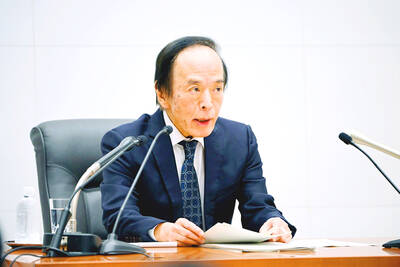Asustek Computer Inc (華碩電腦), the world's largest motherboard maker, is tapping into the market for budget notebook PCs with a slew of products scheduled for launch in the second half of the year.
"Tech giants such as Intel Corp don't want to miss out on the potential of the budget PC segment, and we are working with [Intel] to tap into the market," confirmed an Asustek official, who requested anonymity, in a telephone interview yesterday.
He was responding to a report that came out yesterday in the Chinese-language Commercial Times, which said Asustek would introduce a series of low-priced PCs based on Intel's Classmate PC platform in the second half of the year.
Joining hands with Intel offers Asustek the chance to move into a new segment, while beefing up its economies of scale in computer production, the official said.
Details of these budget laptops, including channels and distribution, still need to be ironed out, but they would not be Asustek's main product line, he added.
According to the Commercial Times report, the five budget laptop models would be priced from US$199 to US$549.
They will employ Intel's Solid State Disk with flash memory from 1 gigabyte to 40 gigabytes, instead of the standard mechanical hard drive, the report said.
The 7-inch panels for the notebook computers will be sourced from AU Optronics Corp (
"Although profit margins for these low-end PCs will not be as good as its other notebook computer series, Asustek will immediately benefit from the scale," Daniel Chang (
Asustek's component costs could also drop as its sourcing expands with the additional volume from these budget laptops, he said.
"Asustek's technology strength will help it penetrate various PC segments ... Its global notebook market share will continue to rise at a fast rate," Chang said.
Asustek will be competing against Quanta Computer Inc (
Quanta is the sole manufacturer of the One Laptop per Child (OLPC), a project initiated by the Massachusetts Institute of Technology to distribute computers to children in developing countries.
Using the Linux operating system and low-cost materials, these notebook computers, priced at US$150 a unit, will come onstream later this year.
Quanta has said it aims to deliver more than 10 million OLPCs within the first 12 months.
However, Merrill Lynch cautioned last month that while the OLPC business model might be viable in its initial stage, users would face problems when they need maintenance help, software debugging, updates or help in handling viruses.
Shares of Asustek edged up 1.5 percent to NT$79.8 (US$2.41) on the Taiwan Stock Exchange yesterday, while shares of Quanta dropped 0.6 percent to NT$50.7.

Taiwan Semiconductor Manufacturing Co (TSMC, 台積電) last week recorded an increase in the number of shareholders to the highest in almost eight months, despite its share price falling 3.38 percent from the previous week, Taiwan Stock Exchange data released on Saturday showed. As of Friday, TSMC had 1.88 million shareholders, the most since the week of April 25 and an increase of 31,870 from the previous week, the data showed. The number of shareholders jumped despite a drop of NT$50 (US$1.59), or 3.38 percent, in TSMC’s share price from a week earlier to NT$1,430, as investors took profits from their earlier gains

In a high-security Shenzhen laboratory, Chinese scientists have built what Washington has spent years trying to prevent: a prototype of a machine capable of producing the cutting-edge semiconductor chips that power artificial intelligence (AI), smartphones and weapons central to Western military dominance, Reuters has learned. Completed early this year and undergoing testing, the prototype fills nearly an entire factory floor. It was built by a team of former engineers from Dutch semiconductor giant ASML who reverse-engineered the company’s extreme ultraviolet lithography (EUV) machines, according to two people with knowledge of the project. EUV machines sit at the heart of a technological Cold

TAIWAN VALUE CHAIN: Foxtron is to fully own Luxgen following the transaction and it plans to launch a new electric model, the Foxtron Bria, in Taiwan next year Yulon Motor Co (裕隆汽車) yesterday said that its board of directors approved the disposal of its electric vehicle (EV) unit, Luxgen Motor Co (納智捷汽車), to Foxtron Vehicle Technologies Co (鴻華先進) for NT$787.6 million (US$24.98 million). Foxtron, a half-half joint venture between Yulon affiliate Hua-Chuang Automobile Information Technical Center Co (華創車電) and Hon Hai Precision Industry Co (鴻海精密), expects to wrap up the deal in the first quarter of next year. Foxtron would fully own Luxgen following the transaction, including five car distributing companies, outlets and all employees. The deal is subject to the approval of the Fair Trade Commission, Foxtron said. “Foxtron will be

INFLATION CONSIDERATION: The BOJ governor said that it would ‘keep making appropriate decisions’ and would adjust depending on the economy and prices The Bank of Japan (BOJ) yesterday raised its benchmark interest rate to the highest in 30 years and said more increases are in the pipeline if conditions allow, in a sign of growing conviction that it can attain the stable inflation target it has pursued for more than a decade. Bank of Japan Governor Kazuo Ueda’s policy board increased the rate by 0.2 percentage points to 0.75 percent, in a unanimous decision, the bank said in a statement. The central bank cited the rising likelihood of its economic outlook being realized. The rate change was expected by all 50 economists surveyed by Bloomberg. The